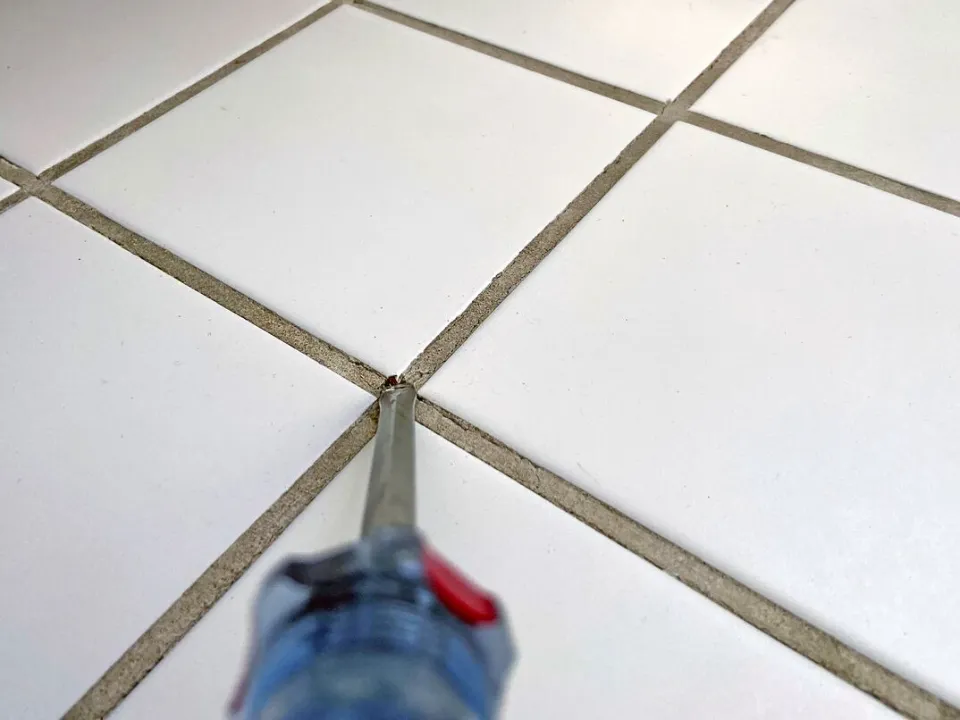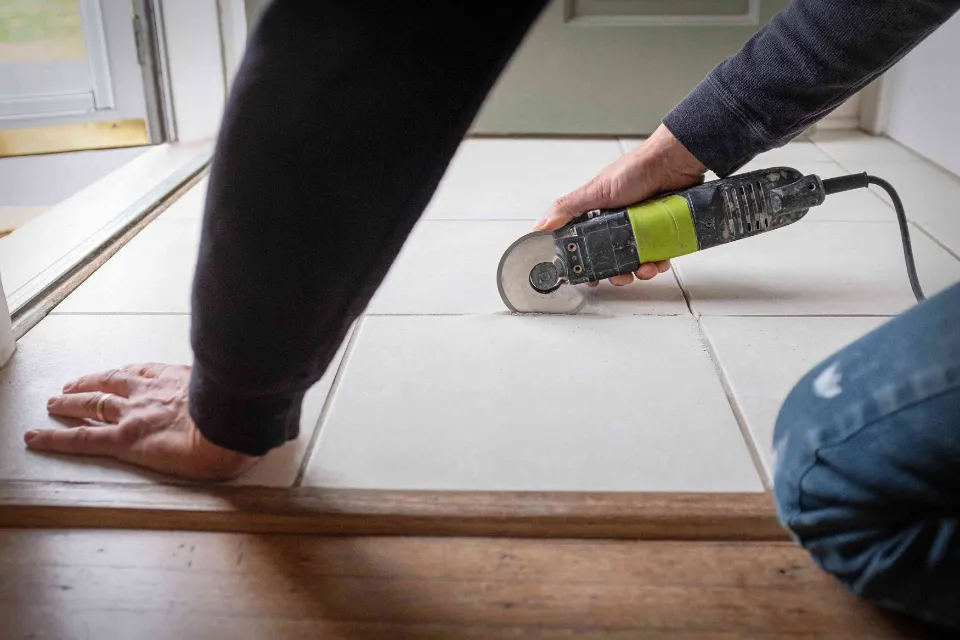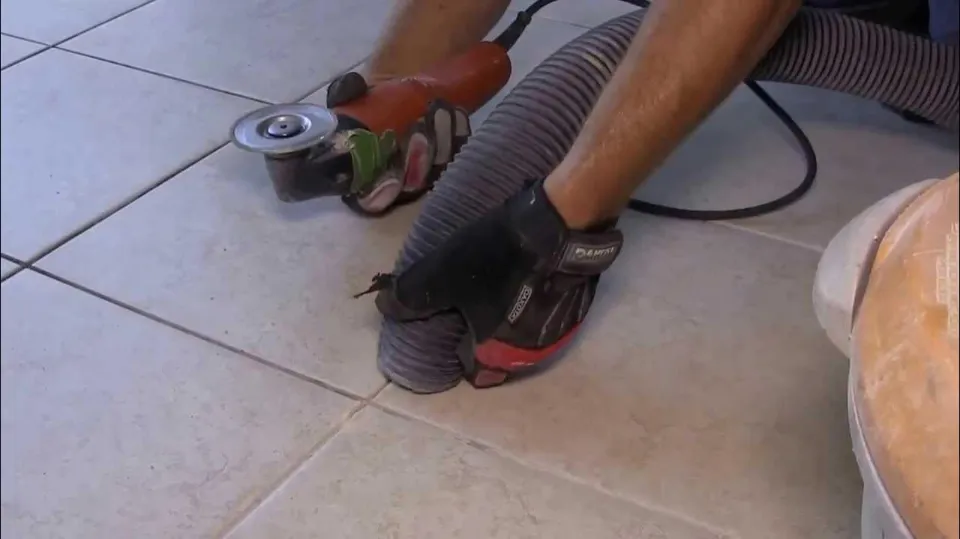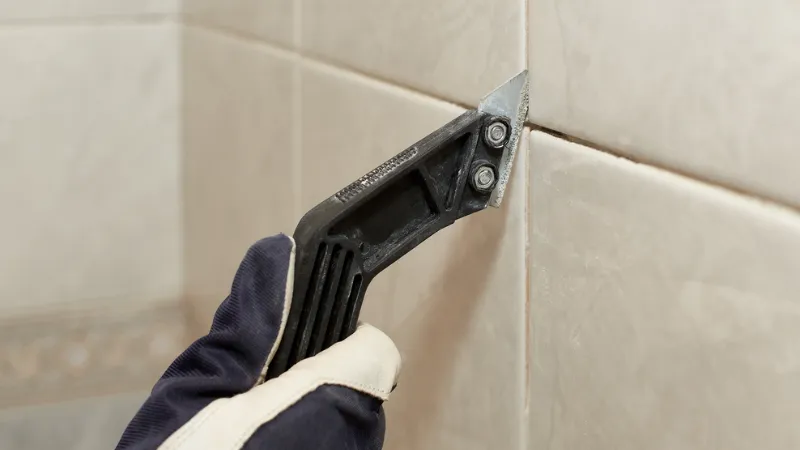In this DIY project guide, we provide some helpful advice on how to remove hard grout from tiles without causing any damage to the tiles’ surface. We also show you solutions for dissolving the hardened grout.
Moisten the warm water with a sponge and apply it to the surface of the tile. After that, gently rub the cement slurry with some fine steel wool as it begins to dissolve and fall off at the same time. After thoroughly cleaning the tiles and removing all remaining hardened grout, wipe the tiles with a damp cloth and allow to air dry. When finished, sand the tile with a dry cloth to complete the task.
For more information, continue reading.
The Basic Method for Hardened Grout Removal
With a sponge, moisten warm water and apply it to the tiles’ surface. After that, rub gently over the grout with some fine wire wool as it starts to dissolve and come off at the same time. Wipe the tile with a damp cloth after it has been thoroughly cleaned and all remaining hardened grout has been removed, then allow it to air dry. Once you’ve finished, polish the tile with a dry cloth to complete the task.
The same procedure will work with floor or quarry tiles, but warm water probably won’t be enough to get rid of the cement-based adhesives that are attached to them. A patio or brick cleaner will work, but since these cleaners are acid-based, you should wear rubber gloves and eye protection.
Before you go ahead and clean the desired area, try a tiny drop in an out of the way corner to make sure that the cleaner is not too strong for the tiles and glaze as this will etch then and ruin them.
You can find clear rinsing instructions on the container of your brick or patio cleaner. You will need to follow these carefully and fully.

How to Remove Grout from Tile – Without Damaging It?
The main concern when attempting to remove grout from tile is scratching the tile. Thankfully, there are a variety of tools and cleaning products you can use to keep your tile free from stains and scratches. Naveen Tikaram is a kitchen specialist and contributing author at 10 Minute Homemaking(opens in new tab). Tikaram suggests following a step-by-step procedure when removing grout from tile.
Try Warm Water
If your grout is still relatively new, it is frequently that simple, despite sounding too easy. To remove soft grout from your tile, all you need is some warm water and a non-scratch scouring pad. Of course, as Tikaram points out, ‘this will remove the white stain from the tile but not the stained grout lines.’ If you need a heavier-duty removal, move on to the next step.
Use Oil Soap on Grout Lines
If you’re trying to remove not just the grout that’s stained the surface of the tiles but old grout between tiles, Tikaram recommends using Murphy’s Oil Soap diluted in hot water ‘If you want to clear up as much staining as you can.’ Just the tip of your scouring pad or, even better, the tip of a cloth should be used. You must take care to avoid getting Murphy’s Oil Soap on the tile surface as this could result in damage. Before the grout is entirely removed, you might need to repeat this application a few times.
Use a Grout Saw for Stubborn Areas
If oil soap and water aren’t quite doing it, you use a grout saw to remove the grout without damaging the tile. To cut the grout between tiles, you can use a grout saw, which has a small, serrated blade.
Suggested reading: What color grout to use with gray tile? Overall, some colored grout contrasts with gray tiles: light gray, off white, taupe, brown, charcoal gray, cream, dark gray, and gray porcelain.

Solutions for Dissolving the Hardened Grout
You must lubricate the grout even if you choose to scrape and rub the grout away. Warm water is preferred because it won’t damage the tile and will start to loosen the grout.
We understand that this might not be sufficient to remove your grout, so there are a few other options. You should test these out on a small, hidden area before using them to make sure you understand how they will affect the tiles.
Here are some of the more popular solutions that people use to assist the removal of hard grout:
- Sugared Water– (not to be confused with sugar soap). Stir some warm water and regular white sugar together. You should experiment to determine what works best, but the ideal ratio is roughly 1 part sugar to 10 parts water. To remove grout, sponge sugar water into the area and let it sit for about an hour. Then, try rubbing and scraping the grout off while continuing to lubricate it with more sugared water. Although we haven’t tried it, we have reliable information that it works well. It will certainly be kind to the tile, which is a very important factor
- Vinegar– Because vinegar is an acid, you must be cautious not to damage the tile’s surface. Make sure you have plenty of water to dilute and wash off any excess vinegar that gets where it shouldn’t by testing it first to see how the tile handles it. Wearing gloves and not allowing the vinegar to sit on the tile’s surface are recommended. Preserve airflow in the space. Continue to scrape the grout while applying small amounts of vinegar until all the hardened grout has been removed. Then wash the whole area down thoroughly
- Other Acids and Sulfamic Acid– The procedure is the same as it is for vinegar, except that these are stronger acids. Make sure that you test first to ensure you don’t ruin your tiles. Wear gloves and safety glasses, and make sure the area is well ventilated. Watch out for splashes and flicks of acid – these need to be washed off whatever surface they land on immediately with the water you will have handy
- Brick and Patio Cleaners– These are excellent agents for liquifying and dissolving hardened grout, as previously mentioned. The fact that these cleaners are acid-based and therefore effective requires the same safety precautions. Brick cleaner can be bought in 1 – litre tubs so you do not have to buy the 5 litre tubs you see in most DIY Stores.

FAQs
How Do You Dissolve Hard Grout?
Soften grout on floor tiles by soaking it with sugar water, a lemon juice solution, or a vinegar solution for 10–20 minutes. Use sulfamic acid or a grout dissolver spray instead for a more powerful method of removing grout. Use a blow dryer or heat gun to warm the grout between the wall tiles.
Does Vinegar Dissolve Grout?
You shouldn’t use vinegar to clean grout that hasn’t been sealed, needs to be resealed, or is damaged. The vinegar penetrates into the pores of the grout, further weakening the material. Vinegar etching or wearing away the grout over time will deteriorate its condition.
Does WD 40 Remove Grout?
Shower door soap scum can be easily removed with WD-40 spray, and it can also be avoided in the future. It’s also a great way to clean the grout between your bathroom tiles, remove stubborn stains from your toilet bowl, and rust stains on porcelain caused from aerosol cans.
Does Baking Soda Dissolve Grout?
Baking soda is mildly abrasive so it helps to remove the dirt that is stuck in the porous grout surfaces without causing any damage. In addition to brightening and killing germs, hydrogen peroxide is a natural bleach substitute. Plus it is non-toxic and decomposes into water and oxygen.
Does Dried Grout Come Off Tile?
Once it has cured, however, old grout can be difficult to clean from tiled floors and walls. Your first thought might be to use a metal tool, like a putty knife, to chip it off, but doing so could harm the tiles. Instead, it is advised to use non-metal tools to soak, gently scrape, and scrub the grout.
Summary: Should You Remove or Clean Old Grout on Tiled Floors?
Is it really necessary to remove the old grout, or could cleaning bring it back to life? It’s a good idea to try cleaning it first before giving up on it altogether. The solution here is either vinegar or bleach. Failing those ingredients, Takaram reminds DIYers that ‘grout is made of sand, Portland cement (commonly called concrete), and latex, so any household cleaners that are recommended for natural stone – such as mineral spirits or vinegar – will work.’
If you have any questions, please leave a comment. My Prime Home tries to give you the best home improvement information. Don’t forget to share the post. Thank you for reading.
See also:



